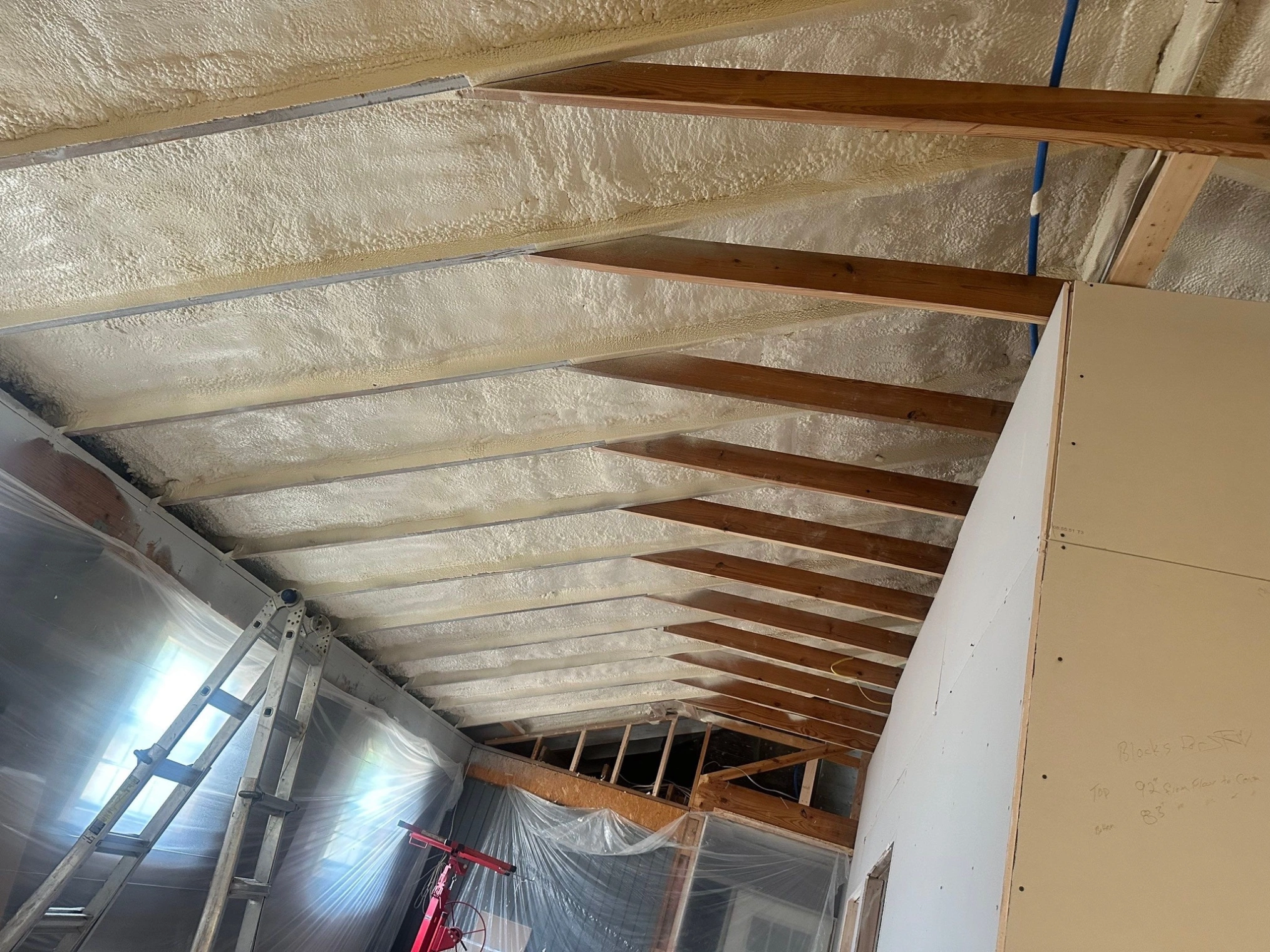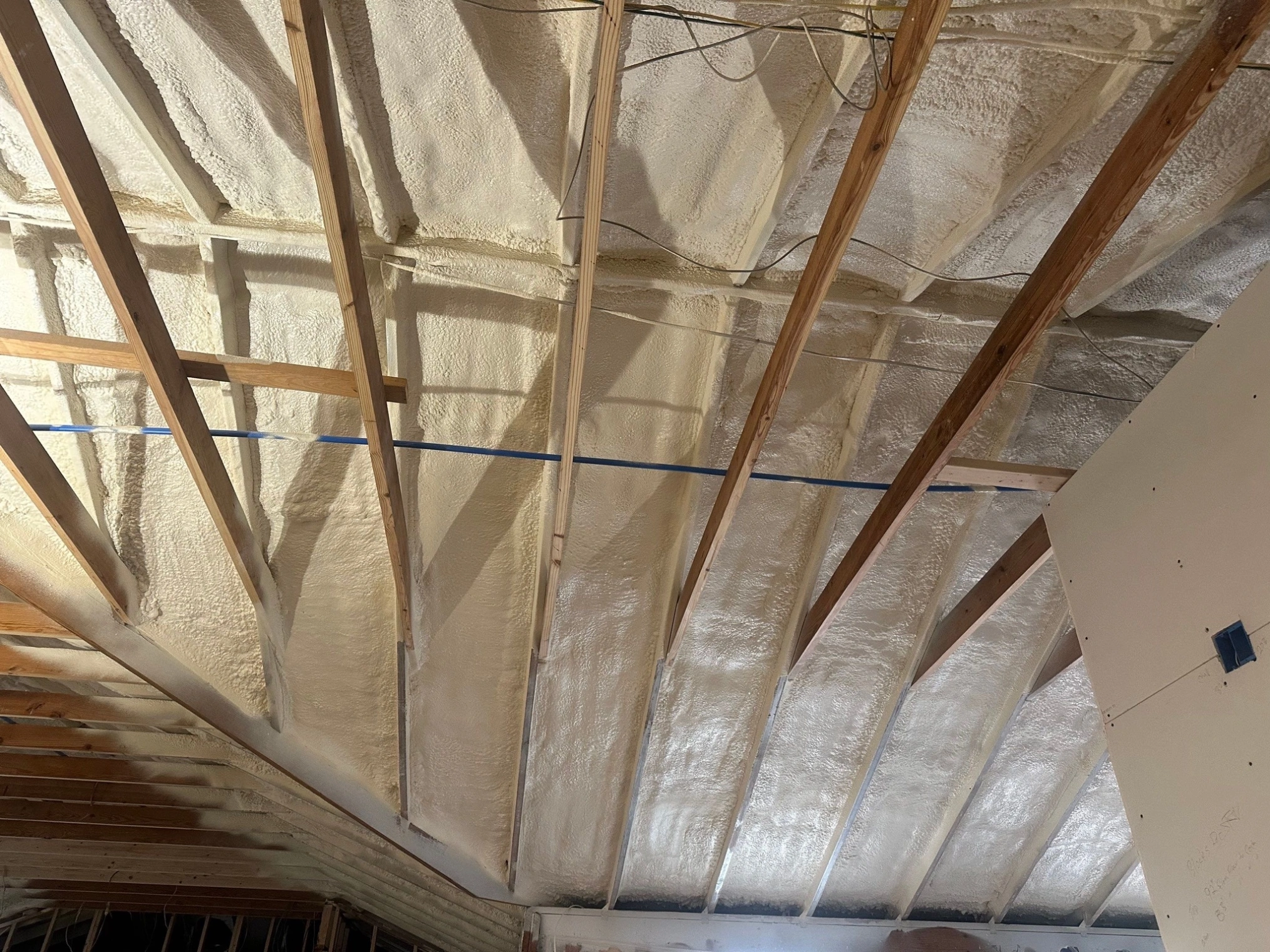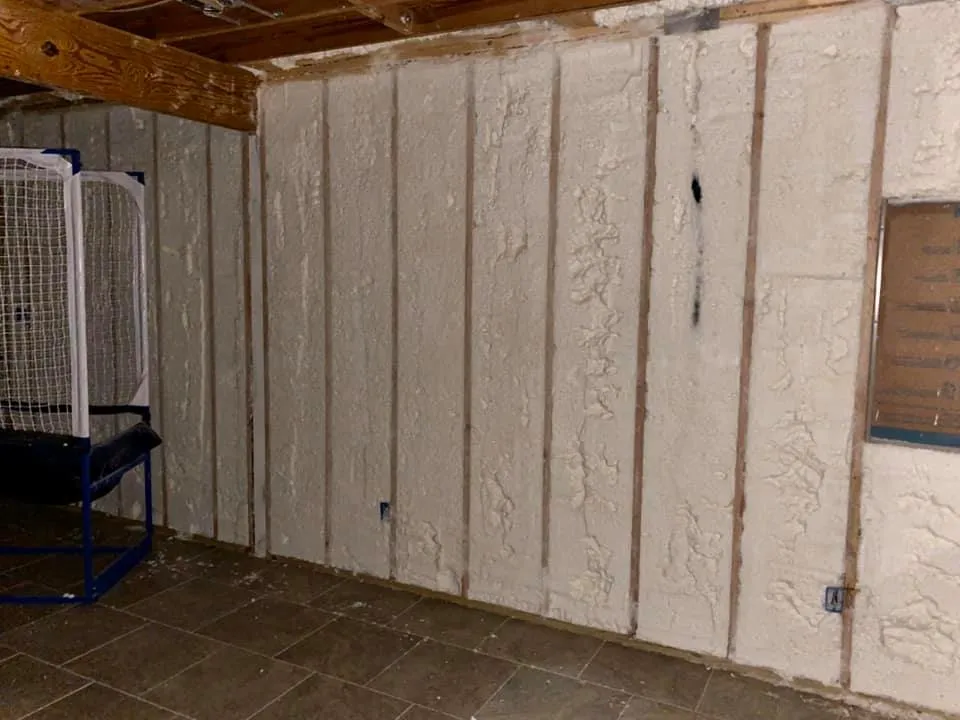Spray foam insulation significantly reduces noise transmission through walls, floors, and ceilings by creating an airtight seal that blocks sound waves from passing between spaces. Unlike traditional insulation materials that leave gaps and air pockets, spray foam expands to fill every crack and crevice, eliminating the pathways that allow sound to travel. This dual-function approach provides both thermal efficiency and acoustic control, making it particularly effective for properties in Luling, TX where outdoor noise from traffic, construction, and industrial activities can impact indoor comfort.
The soundproofing effectiveness of spray foam stems from its unique cellular structure and application method. When properly installed by experienced professionals, spray foam creates a continuous barrier that reduces airborne noise by 3-8 decibels compared to traditional fiberglass insulation. This translates to noticeably quieter indoor environments, with the added benefit of improved energy efficiency that helps property owners save on utility costs year-round.
Understanding Spray Foam’s Acoustic Properties
The science behind spray foam’s soundproofing capabilities lies in its density and air-sealing properties. According to the Spray Polyurethane Foam Alliance, properly installed spray foam insulation can reduce sound transmission by up to 80% compared to uninsulated spaces. This performance stems from the material’s ability to eliminate air gaps that traditional insulation methods often leave behind.
Spray foam works through two primary acoustic mechanisms: absorption and blocking. The foam’s cellular structure absorbs sound energy, while its continuous application creates a physical barrier that prevents sound waves from transmitting through building materials. This combination makes it particularly effective against both high-frequency sounds like voices and music, and low-frequency noise such as HVAC systems and traffic rumble.
Sound Transmission Class Ratings
Different spray foam types deliver varying levels of acoustic performance based on their density and application thickness:
| Foam Type | STC Rating | Typical Applications | Noise Reduction |
|---|---|---|---|
| Open Cell | 36-39 | Interior walls, attics | Moderate (3-5 dB) |
| Closed Cell | 45-50 | Exterior walls, basements | High (6-8 dB) |
| High-Density Closed Cell | 50-55 | Commercial spaces, studios | Maximum (8-12 dB) |
Bonus Tip: For maximum soundproofing effectiveness, combine spray foam with acoustic-rated drywall or add mass-loaded vinyl barriers during installation. This layered approach can achieve STC ratings exceeding 60.
Climate Considerations for Luling Properties
Texas Gulf Coast humidity and temperature fluctuations create unique challenges for both thermal and acoustic insulation. Spray foam’s moisture resistance prevents the degradation that affects traditional materials, maintaining consistent soundproofing performance over time. The material’s expansion properties work particularly well in older Luling homes where settling and wood movement create gaps that allow both air and sound infiltration.
During summer months when air conditioning systems run continuously, spray foam’s dual benefit becomes especially valuable. The same airtight seal that blocks outdoor noise also reduces HVAC system workload, leading to quieter indoor environments and lower energy bills. Research from the Building Performance Institute shows that homes with spray foam insulation experience 40% less HVAC noise transmission compared to traditionally insulated properties.
Regional Performance Factors
| Environmental Factor | Impact on Performance | Spray Foam Advantage |
|---|---|---|
| High Humidity (80%+) | Traditional materials degrade | Moisture resistant, maintains integrity |
| Temperature Swings | Material expansion/contraction | Flexible, self-sealing properties |
| Seasonal Storms | Wind noise penetration | Superior air sealing blocks weather sounds |
| Urban Development | Increased traffic noise | Continuous barrier blocks low-frequency sounds |
Application Methods for Maximum Soundproofing
Professional installation technique directly impacts acoustic performance. Spray foam must be applied at specific thicknesses to achieve optimal sound dampening while maintaining proper building envelope function. Experienced installers understand that acoustic performance requires different application strategies than purely thermal applications.
For residential soundproofing projects, open-cell foam typically receives application at 3-4 inch thickness in wall cavities, while closed-cell applications range from 2-3 inches depending on the specific noise control requirements. The foam’s expansion rate must be carefully managed to ensure complete cavity filling without over-pressurization that can damage building materials.
Bonus Tip: Schedule spray foam installation during moderate weather conditions (60-80°F) for optimal expansion characteristics and acoustic performance. Extreme temperatures can affect the foam’s cellular structure and reduce soundproofing effectiveness.
Installation Considerations by Location
Different areas of properties require specific approaches for maximum acoustic benefit:
- Interior Walls: Open-cell foam works effectively for controlling sound transmission between rooms while maintaining cost efficiency. The lower density allows for better sound absorption within the foam structure.
- Exterior Walls: Closed-cell foam provides superior protection against outdoor noise sources while delivering enhanced thermal performance. The higher density creates a more effective sound barrier.
- Floor/Ceiling Assemblies: Impact noise reduction requires careful attention to thermal bridging and structural connections. Spray foam application must account for both airborne and structure-borne sound transmission.
Comparing Soundproofing Options
Property owners evaluating acoustic insulation solutions benefit from understanding performance differences across available materials:
| Material | STC Rating | Lifespan | Maintenance |
|---|---|---|---|
| Fiberglass Batts | 32-34 | 15-25 years | Periodic replacement |
| Cellulose Blown-In | 35-38 | 20-30 years | Settling adjustment |
| Mineral Wool | 40-45 | 30+ years | Minimal |
| Open Cell Spray Foam | 36-39 | 30+ years | None |
| Closed Cell Spray Foam | 45-50 | 30+ years | None |
Market data from the North American Insulation Manufacturers Association indicates that spray foam installations have increased 15% annually since 2020, driven primarily by performance advantages in both energy efficiency and noise control applications.

Things to Consider Before Making a Decision
Property age and construction type significantly influence spray foam effectiveness for soundproofing applications. Older homes with balloon framing may require additional air sealing measures beyond spray foam application to achieve maximum acoustic performance. Modern construction with engineered lumber and advanced framing techniques typically sees more predictable results from spray foam installation.
Budget considerations extend beyond initial material costs to include long-term value through reduced HVAC expenses and improved property values. Energy Star data shows that comprehensive spray foam insulation can reduce utility costs by 20-30%, helping offset higher upfront investment over 3-5 years.
Existing HVAC system capacity requires evaluation before spray foam installation in Luling, TX. The improved building envelope performance may necessitate system adjustments or downsizing to maintain proper humidity control and air quality. Professional load calculations help determine any required modifications.
Building code compliance varies by jurisdiction and application type. Luling properties must meet Texas residential code requirements for thermal barriers and fire safety when using spray foam insulation. Professional installers ensure all installations meet current building standards.
Professional Spray Foam Services in Luling
Stellrr Insulation & Spray Foam delivers comprehensive insulation solutions designed to enhance both thermal performance and acoustic comfort for residential and commercial properties. The company’s experienced team understands the unique requirements of Texas Gulf Coast construction and climate conditions.
- Residential Spray Foam Insulation: Complete home insulation services using both open-cell and closed-cell spray foam applications. Each project receives custom design based on specific soundproofing goals and building characteristics.
- Commercial Spray Foam Insulation: Large-scale insulation projects for office buildings, retail spaces, and industrial facilities requiring superior noise control and energy efficiency.
- Attic Insulation: Specialized spray foam applications for attic spaces that eliminate thermal bridging while reducing noise transmission from roof surfaces and mechanical equipment.
- Wall Insulation: Retrofit and new construction wall insulation services using spray foam to create continuous acoustic and thermal barriers.
Common Questions About Spray Foam Soundproofing
How long does spray foam soundproofing last?
Properly installed spray foam maintains acoustic performance for 30+ years without degradation. The material’s chemical stability and moisture resistance prevent the settling and deterioration that affects traditional insulation materials.
Can spray foam eliminate all noise?
While spray foam significantly reduces sound transmission, complete noise elimination requires additional measures such as acoustic-rated assemblies and structural modifications. Typical installations achieve 60-80% noise reduction.
Does spray foam work for low-frequency sounds?
Closed-cell spray foam effectively reduces low-frequency noise like traffic rumble and HVAC vibration through its density and air-sealing properties. Open-cell foam provides less low-frequency control but excels at mid and high-frequency absorption.
Is spray foam installation disruptive?
Professional installation typically requires 1-2 days for residential projects with minimal disruption to daily activities. The foam cures within 24 hours, allowing normal building occupancy to resume quickly.
Maximizing Your Investment
Strategic spray foam placement delivers the greatest acoustic benefit per dollar invested. Focus installation efforts on areas with the highest noise transmission potential: shared walls, exterior walls facing noise sources, and floor/ceiling assemblies between occupied spaces.
Bonus Tip: Combine spray foam installation with other home improvement projects like electrical or plumbing updates to maximize efficiency and minimize disruption. This approach often reduces overall project costs through shared labor and access requirements.
Building envelope testing after installation verifies both thermal and acoustic performance. Blower door tests confirm air sealing effectiveness, while acoustic measurements validate sound reduction achievements. This data helps property owners understand their investment results and identify any areas requiring additional attention.
Professional installers provide warranty coverage for both material and workmanship, ensuring long-term performance and value protection. Quality installations backed by manufacturer warranties deliver peace of mind along with improved comfort and property value.
Making the Right Choice for Your Property
Spray foam insulation delivers measurable soundproofing benefits alongside energy efficiency improvements, making it a practical investment for Luling property owners facing noise challenges. The material’s long-term performance and maintenance-free operation provide value that extends well beyond initial installation costs.
Successful soundproofing projects begin with accurate assessment of noise sources, building construction characteristics, and performance goals. Professional evaluation ensures appropriate material selection and application methods to achieve desired acoustic improvements within available budgets.
Consider your property’s specific needs, including existing HVAC systems, building age, and primary noise concerns when evaluating spray foam options. The investment in quality materials and professional installation typically pays dividends through improved comfort, reduced energy costs, and enhanced property value.
Get Expert Insulation Guidance
Transform your Luling property’s comfort and energy efficiency with professional spray foam insulation services. Stellrr Insulation & Spray Foam brings extensive experience in both thermal and acoustic applications to every project, ensuring optimal performance and lasting value.
Contact our team to discuss your specific soundproofing needs and receive detailed recommendations tailored to your property’s requirements. Professional consultation helps identify the most cost-effective approaches to achieve your acoustic and energy efficiency goals.
Stellrr Insulation & Spray Foam
Phone: (512) 710-2839
Email: info@stellrr.com
Schedule your property evaluation today and discover how spray foam insulation can create the quiet, comfortable environment you deserve while reducing energy costs year-round.
Frequently Asked Questions
What thickness of spray foam is needed for effective soundproofing?
Open-cell foam requires 3-4 inches for optimal acoustic performance, while closed-cell foam achieves similar results at 2-3 inches. Thicker applications provide diminishing returns for soundproofing while increasing material costs unnecessarily.
How does spray foam soundproofing compare to mass-loaded vinyl?
Spray foam provides both thermal and acoustic benefits with permanent installation, while mass-loaded vinyl offers higher STC ratings but requires additional support structure and offers no thermal value. Many projects benefit from combining both materials.
Can spray foam be applied over existing insulation for soundproofing?
Existing insulation should be removed before spray foam application to ensure proper adhesion and performance. Spray foam over old materials can trap moisture and reduce both thermal and acoustic effectiveness.
Does spray foam installation require special ventilation considerations?
Proper ventilation during installation protects occupant health and ensures optimal foam curing. Professional installers use appropriate safety equipment and ventilation systems, with buildings typically safe for reoccupancy within 24 hours.
Will spray foam soundproofing affect my property value?
Quality insulation improvements typically increase property values by 2-6% while reducing ongoing utility costs. The combination of energy efficiency and noise control appeals to buyers seeking comfortable, low-maintenance properties.





